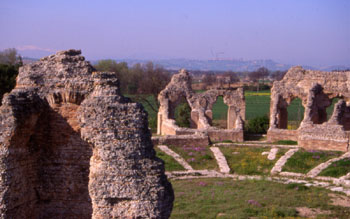 Tourism
Tourism
 Visit the town
Visit the town
 Ricina Archeological Area
Ricina Archeological Area
Ricina Archeological Area and Roman Theatre

- The roman theatre
Villa Potenza - SS 77
Opening time: booking required
+39 0733 271709
+39 0733 256361
mail info@maceratamusei.it
Little is known about the origins of Ricina; reports of iron-age pottery found in the area of the Roman theatre have not been fully verified, while older material, uncovered during the course of excavations undertaken in the 1970s, does not appear to date back further than the 2nd century BC: Compared to the other Roman towns dispersed along the valleys of the Potenza and Chienti rivers, the monumental remains at Ricina are considerable.
In addition to a number of ruins among the fields and which are difficult to reach, you can see a street of paved road, flanked by several buildings, and the great complex of the theatre itself.
The theatre is made up of two orders of porticos, the capitals on the half-columns of the lower level are Ionic, those of the upper level, Doric. Twelve segments of the wall which supported the cavea (the tiers intended for the public) are still visible. In the cavea there are 11 entrances and 12 gates with lintels which gave access to the service area. The scena in the form of a semicircular exedra, communicated with the cavea by means of two gallerys
tel. 0733-2561 fax 0733-256200
e-mail: municipio@comune.macerata.it
e-mail istituzionale (solo per i titolari di PEC): comune.macerata@legalmail.it
P.I. 00093120434 - C.F. 80001650433
- Sito realizzato da RA Computer con il CMS per siti accessibili e-ntRA
- Home
